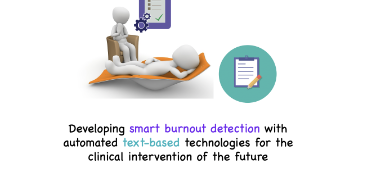BurnoutWords
In this project, detecting the burnout syndrome with the power of natural language processing allows to prepare for the future's digital methods in psychology.
Factsheet
- Lead school School of Engineering and Computer Science
- Institute Institute for Data Applications and Security (IDAS)
- Research unit IDAS / Applied Machine Intelligence
- Funding organisation SNSF
- Duration (planned) 01.03.2021 - 28.02.2022
- Project management Prof. Dr. Mascha Kurpicz-Briki
- Head of project Prof. Dr. Mascha Kurpicz-Briki
- Keywords burnout, psychology, natural language processing, computer science, ai4socialgood
Situation
Studies show that many employees are often or always stressed at work, or feel exhausted after work. Sometimes such chronic stress at work can lead to burnout. The World Health Organization (WHO) has included burnout as a syndrome in the 11th Revision of the International Classification of Diseases (ICD-11) in 2019. Clinical diagnostics of this syndrome is sometimes difficult because symptoms often overlap with other syndromes or medical conditions, such as depression. In clinical psychology, questionnaires (inventories) are used to identify burnout, which are based on multiple-choice tick-box questions. In the literature, this approach, although proven and regularly used in studies and in clinical practice, is sometimes questioned. Problems with such questionnaires can be that patients do not answer honestly or avoid the more extreme answers (or select them particularly often).
Course of action
Much potential lies in the expansion of such questionnaires with free-text questions, or the analysis of transcripts of interviews. So far, however, such approaches have not yet gained acceptance due to the time-consuming manual analysis. In this project, innovative technologies from computer science and especially from the field of natural language processing are brought together with existing tools from clinical psychology. Automatic text analysis will provide the basis for establishing new methods for the detection of burnout.
Result
The project investigates on the basis of different data sets how texts of people suffering from burnout differ from those of other persons, using methods from the field of machine learning. In different setups anonymized texts in different languages (German, English, French) were examined and first promising results could be recorded. In a recently published scientific paper, the project team presented a new method for burnout detection in English texts: Anonymized texts were classified, depending on the topic and partly by means of manual selection, into three categories: Burnout, Depression, and a control group of various other topics. Based on this, different systems (so-called classifiers) were trained using machine learning. In order to achieve the best possible result, these systems were then combined to form a so-called ensemble classifier. A text segment to be evaluated by the system is evaluated by the different classifiers, which determine whether there is an indication for burnout. By voting on these different results of the individual classifiers, the ensemble classifier then determines whether an overall indication for burnout should be assumed or not.
Looking ahead
The results from this initial study, which explores the basics of the technology, are promising and will now be further validated. Further studies on other languages (especially German and French) will be conducted. Because of the completely anonymized data in the previous studies, the training data must also be extended to prevent bias. It must be ensured that the final training data for such a system covers all groups of society as well as possible. The project is also investigating what a clinical tool based on this technology would look like in the future. The research is in the field of augmented intelligence and would support the clinical professional in a later use. Augmented Intelligence aims to support people in their daily tasks by means of artificial intelligence, not to replace them.

